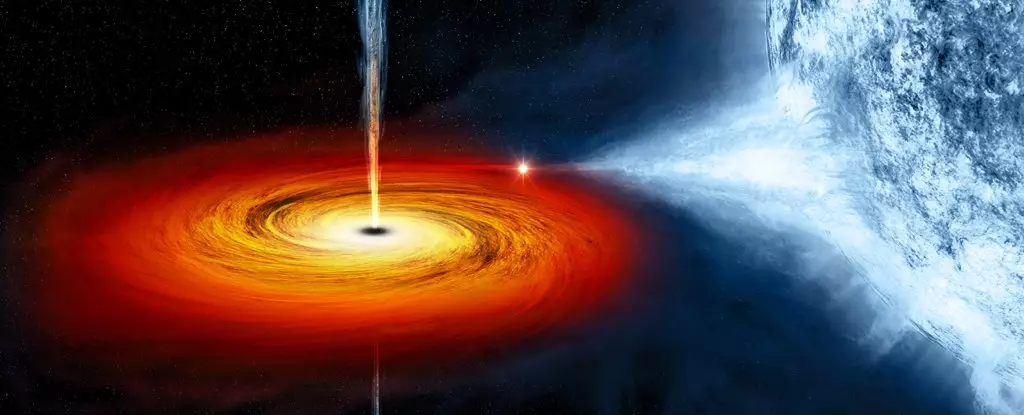For many years, astrophysicists operated under the assumption that the most energetic gamma rays in the universe were predominantly birthed from the tumultuous environments surrounding supermassive black holes. These gargantuan entities, often found at the centers of distant galaxies, were seen as the primary engines behind the formation of ultra-high-energy photons. However, recent groundbreaking research has shifted this paradigm. A lesser-known microquasar, V4641 Sagittarii, located only 20,000 light-years from Earth in the constellation Sagittarius, has surprised scientists by producing gamma rays with energies soaring up to an extraordinary 200 teraelectronvolts (TeV). This remarkable finding not only redefines our understanding of cosmic gamma-ray sources but also enriches our grasp of black hole mechanics within our own galactic neighborhood.
Microquasars, as their name suggests, are miniature versions of the traditional quasars that permeate our universe. While quasars are powered by supermassive black holes consuming vast amounts of gas and forming bright active galactic cores, microquasars are associated with smaller black holes that often accrete materials from companion stars. Conventional wisdom in astrophysics suggested that these microquasars produced much less energetic emissions—typically in the tens of gigaelectronvolts range compared to their more massive counterparts. The study of V4641 Sagittarii, however, presents a compelling challenge to this notion, as it has exhibited capabilities comparable to those of quasars.
Sabrina Casanova from the Institute of Nuclear Physics Polish Academy of Sciences pointed out that previous observations of microquasars generated photons with energies significantly lower than those now recorded from V4641 Sagittarii. This new revelation indicates that microquasars have the potential to unleash gamma rays of unprecedented energy levels, underscoring a remarkable intricacy in their behavior that was previously unappreciated.
One of the key players in this discovery is the High-Altitude Water Cherenkov (HAWC) observatory located on the Sierra Negra volcano in Mexico. This state-of-the-art facility is specifically designed to detect high-energy particles as they traverse the cosmos. Utilizing an array of 300 steel tanks filled with purged water, HAWC captures the aftermath of energetic particles colliding with water molecules, resulting in Cherenkov radiation—akin to a sonic boom, but for light.
HAWC’s technology is fairly revolutionary in its ability to create a comprehensive cosmic map. It can monitor 15% of the sky at any given moment and comprehensively scan two-thirds of the sky every day. It was during one of these sky scans that astro-physicist Xiaojie Wang stumbled upon a previously uncharted region exhibiting surprising gamma-ray emissions. This unexpected bright spot ultimately led to the identification of V4641 Sagittarii as the source of high-energy gamma rays.
The implications of this discovery extend beyond merely recognizing a new source of cosmic gamma rays—it opens the door for a deeper comprehension of quasar dynamics. While supermassive black holes typically evolve and interact over million-year timescales, microquasars like V4641 Sagittarii operate on a far shorter timeframe, often creating processes we can observe within days. This condensed timescale allows astrophysicists to study complex physical processes related to quasar activity in a more immediate and relatable manner.
The results from V4641 Sagittarii not only boost our understanding of gamma-ray production mechanisms but also assert the idea that microquasars may serve as natural laboratories for observing phenomena akin to those taking place around supermassive black holes. With the ability to replicate high-energy processes previously thought restricted to quasars, these microquasars illuminate how the universe wields its most energetic particles in diverse scenarios.
The discovery of the high-energy gamma rays generated by V4641 Sagittarii marks a significant milestone in astrophysics, reshaping our perception of high-energy radiation sources. As scientists further probe these intricate cosmic engines, they stand poised to unravel secrets not only about black holes but also about the very fabric of our universe. In a cosmos rich with mysteries, V4641 Sagittarii serves as a vivid reminder that we are just beginning to scratch the surface of understanding the mechanisms that govern celestial phenomena on both grand and miniature scales. This evolving knowledge may well guide future explorations into the high-energy realms of the universe and redefine our quest for comprehension beyond the boundaries of black hole physics.


Leave a Reply